2012 Seat Ibiza 5D technical data
[x] Cancel search: technical dataPage 61 of 280

59
Cockpit
Multifunction display (MFI)*
The multifunction display (MFI) shows you information on
the journey and fuel consumption.
Fig. 34 Window wiper
lever: button A and rocker
switch B
The multifunction system uses two automatic memories: 1 - Trip
memory and 2 - Total memory . The selected memory will be shown
in the upper right-hand corner of the display.
Selecting a memory
– With the ignition switched on, briefly press button ⇒ Fig. 34 A
on the window wiper lever to move from one memory to anoth-
er.
Resetting a memory
– Select the memory that you would like to reset.
– Press and hold button A
on the window wiper lever for at least
2 seconds. The trip memory 1
collects the travel and consumption rates from the mo-
ment the ignition is switched on until it is switched off. If the journey is con-
tinued within two hours of switching off the ignition, the new values will be
added to the existing trip recorder memory. The memory will automatically
be deleted if the journey is interrupted for more than two hours.
The total memory 2 collects the trip data for any number of individual jour-
neys (even if the ignition is switched off for longer than two hours) up to a
total of 19 hours and 59 minutes travel time or 1999 km (miles) distance
travelled. The memory will automatically be deleted if one of the named val-
ues is reached.
Information in the multifunction display (MFI)*
Fig. 35 Windscreen wip-
er and windscreen wash
lever: button A and rocker
switch B
You can switch between the following displays in the multifunction display
(MFI) by operating rocker switch ⇒ Fig. 35 B
on the window wiper lever.
Memory displays
● Driving speed
● Journey duration
Safety FirstOperating InstructionsPractical TipsTechnical Specifications
Page 129 of 280
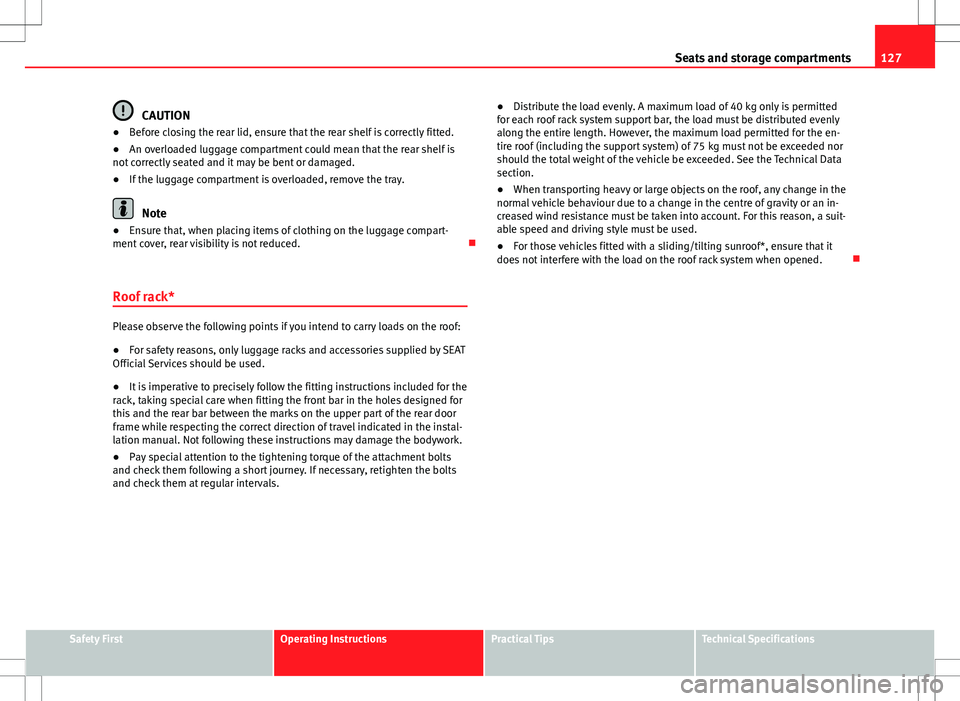
127
Seats and storage compartments
CAUTION
● Before closing the rear lid, ensure that the rear shelf is correctly fitted.
● An overloaded luggage compartment could mean that the rear shelf is
not correctly seated and it may be bent or damaged.
● If the luggage compartment is overloaded, remove the tray.
Note
● Ensure that, when placing items of clothing on the luggage compart-
ment cover, rear visibility is not reduced.
Roof rack*
Please observe the following points if you intend to carry loads on the roof:
● For safety reasons, only luggage racks and accessories supplied by SEAT
Official Services should be used.
● It is imperative to precisely follow the fitting instructions included for the
rack, taking special care when fitting the front bar in the holes designed for
this and the rear bar between the marks on the upper part of the rear door
frame while respecting the correct direction of travel indicated in the instal-
lation manual. Not following these instructions may damage the bodywork.
● Pay special attention to the tightening torque of the attachment bolts
and check them following a short journey. If necessary, retighten the bolts
and check them at regular intervals. ●
Distribute the load evenly. A maximum load of 40 kg only is permitted
for each roof rack system support bar, the load must be distributed evenly
along the entire length. However, the maximum load permitted for the en-
tire roof (including the support system) of 75 kg must not be exceeded nor
should the total weight of the vehicle be exceeded. See the Technical Data
section.
● When transporting heavy or large objects on the roof, any change in the
normal vehicle behaviour due to a change in the centre of gravity or an in-
creased wind resistance must be taken into account. For this reason, a suit-
able speed and driving style must be used.
● For those vehicles fitted with a sliding/tilting sunroof*, ensure that it
does not interfere with the load on the roof rack system when opened.
Safety FirstOperating InstructionsPractical TipsTechnical Specifications
Page 176 of 280

174Driving and the environment
If the trailer has a 7-pin plug you will need to use an adapter cable. This is
available in any Technical Service.
Trailer weight/drawbar load
Never exceed the authorised trailer weight. If you do not load the trailer up
to the maximum permitted trailer weight, you can then climb correspond-
ingly steeper slopes.
The maximum trailer weights listed are only applicable for altitudes up to
1000 m above sea level. With increasing altitude the engine power and
therefore the vehicle climbing ability are impaired because of the reduced
air density. The maximum trailer weight has to be reduced accordingly. The
weight of the vehicle and trailer combination must be reduced by 10% for
every further 1000 m (or part thereof). The gross combination weight is the
actual weight of the laden vehicle plus the actual weight of the laden trailer.
When possible, operate the trailer with the maximum permitted drawbar
load on the ball joint of the towing bracket, but do not exceed the specified
limit.
The figures for trailer weights and drawbar loads that are given on the data
plate of the towing bracket are for certification purposes only. The correct
figures for your specific model, which may be lower than these figures for
the towing bracket, are given in the vehicle documentation or in ⇒ chap-
ter Technical Data.
Distributing the load
Distribute loads in the trailer so that heavy objects are as near to the axle as
possible. Loads carried in the trailer must be secured to prevent them mov-
ing.
Tyre pressure
Set tyre pressure to the maximum permissible pressure shown on the stick-
er on the inside of the fuel tank flap. Set the tyre pressure of the trailer tyres
in accordance with the trailer manufacturer's recommendations. Exterior mirrors
Check whether you can see enough of the road behind the trailer with the
standard rear vision mirrors. If this is not the case, you should have addi-
tional exterior mirrors fitted. Both exterior mirrors should be mounted on
hinged extension brackets. Adjust the mirrors to give sufficient vision to the
rear.
WARNING
Never transport people in a trailer. This could result in fatal accidents.
Note
● Towing a trailer places additional demands on the vehicle. We recom-
mend additional services between the normal inspection intervals if the ve-
hicle is used frequently for towing a trailer.
● Find out whether special regulations apply to towing a trailer in your
country.
Ball coupling of towing bracket*
The ball coupling is provided with instructions on fitting and removing the
ball coupling of the towing bracket.
WARNING
The towing bracket ball coupling must be stored securely in the luggage
compartment to prevent them being flung through the vehicle and caus-
ing injury.
Note
● By law, the ball coupling must be removed if a trailer is not being towed
if it obscures the number plate.
Page 231 of 280

229
If and when
Fuses in engine compartment above battery
Fig. 142 Fuses in engine
compartment
Non-metal fuses
NumberConsumerAmpsS1ABS ESC control unit25S2Electroblower climate heater/fan30S3Automatic gearbox control unit30S4Vacant S5Electronic control unit5S6Injection module30
Some of the electrical items listed in the table are only fitted on certain
models or are optional extras.
Please note that the above list contains all data at the time of going to
press, so it is subject to modifications. Bulb change
General notes
Before changing any bulb, first turn off the failed component.
Do not touch the glass part of the bulb with your bare hands. The finger-
prints left on the glass will vaporise as a result of the heat generated by the
bulb, causing a reduction in bulb life and condensation on the mirror sur-
face, thus reducing effectiveness.
A bulb must only be replaced by one of the same type. The type is indicated
on the bulb, either on the glass part or on the base.
Below, the light source used for all functions is broken down.
Double headlights - H7 Long Life
- H7
- W5W Long Life - PY 21W
Single headlight - H4 Long Life
- W5W Long Life - PY 21W
Dipped beam
Main beam
Side
Turn signal
Dipped/Main
Side
Turn signal
Safety FirstOperating InstructionsPractical TipsTechnical Specifications
Page 251 of 280
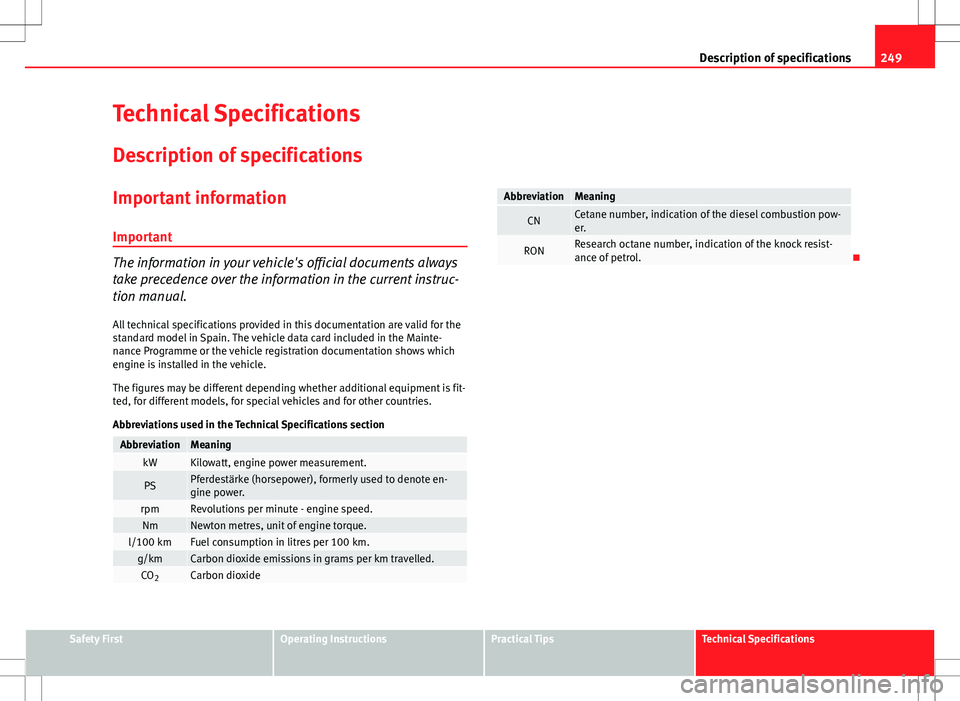
249
Description of specifications
Technical Specifications
Description of specifications Important information
Important
The information in your vehicle's official documents always
take precedence over the information in the current instruc-
tion manual. All technical specifications provided in this documentation are valid for the
standard model in Spain. The vehicle data card included in the Mainte-
nance Programme or the vehicle registration documentation shows which
engine is installed in the vehicle.
The figures may be different depending whether additional equipment is fit-
ted, for different models, for special vehicles and for other countries.
Abbreviations used in the Technical Specifications section
AbbreviationMeaningkWKilowatt, engine power measurement.
PSPferdestärke (horsepower), formerly used to denote en-
gine power.
rpmRevolutions per minute - engine speed.NmNewton metres, unit of engine torque.l/100 kmFuel consumption in litres per 100 km.g/kmCarbon dioxide emissions in grams per km travelled.CO 2Carbon dioxide
AbbreviationMeaning
CNCetane number, indication of the diesel combustion pow-
er.
RONResearch octane number, indication of the knock resist-
ance of petrol.
Safety FirstOperating InstructionsPractical TipsTechnical Specifications
Page 253 of 280
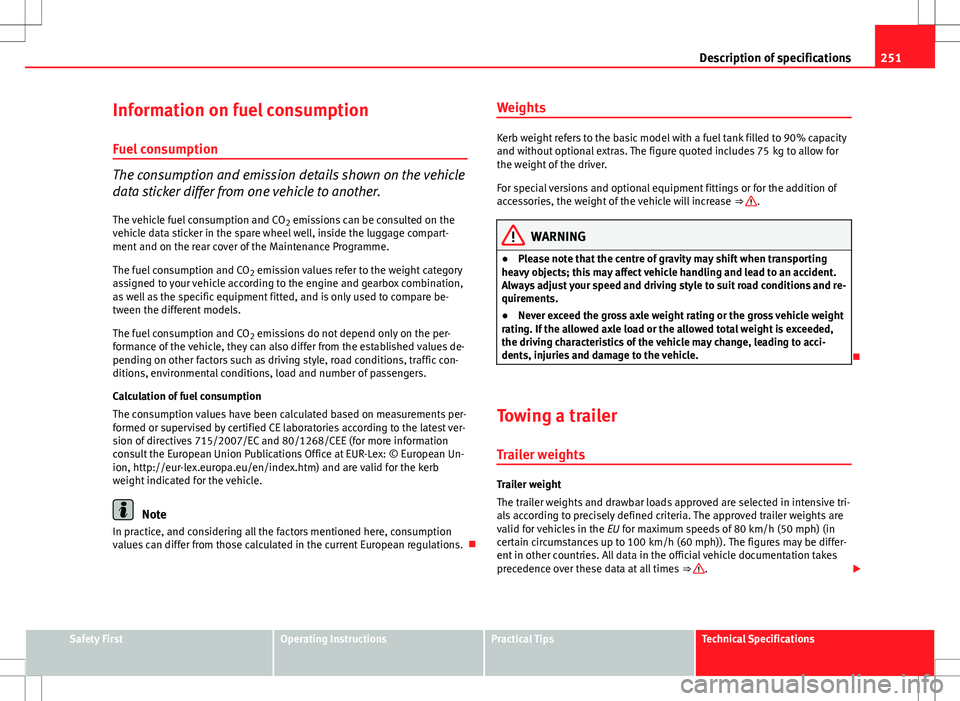
251
Description of specifications
Information on fuel consumption
Fuel consumption
The consumption and emission details shown on the vehicle
data sticker differ from one vehicle to another. The vehicle fuel consumption and CO 2 emissions can be consulted on the
vehicle data sticker in the spare wheel well, inside the luggage compart-
ment and on the rear cover of the Maintenance Programme.
The fuel consumption and CO 2 emission values refer to the weight category
assigned to your vehicle according to the engine and gearbox combination,
as well as the specific equipment fitted, and is only used to compare be-
tween the different models.
The fuel consumption and CO 2 emissions do not depend only on the per-
formance of the vehicle, they can also differ from the established values de-
pending on other factors such as driving style, road conditions, traffic con-
ditions, environmental conditions, load and number of passengers.
Calculation of fuel consumption
The consumption values have been calculated based on measurements per-
formed or supervised by certified CE laboratories according to the latest ver-
sion of directives 715/2007/EC and 80/1268/CEE (for more information
consult the European Union Publications Office at EUR-Lex: © European Un-
ion, http://eur-lex.europa.eu/en/index.htm) and are valid for the kerb
weight indicated for the vehicle.
Note
In practice, and considering all the factors mentioned here, consumption
values can differ from those calculated in the current European regulations. Weights
Kerb weight refers to the basic model with a fuel tank filled to 90% capacity
and without optional extras. The figure quoted includes 75 kg to allow for
the weight of the driver.
For special versions and optional equipment fittings or for the addition of
accessories, the weight of the vehicle will increase
⇒
.
WARNING
● Please note that the centre of gravity may shift when transporting
heavy objects; this may affect vehicle handling and lead to an accident.
Always adjust your speed and driving style to suit road conditions and re-
quirements.
● Never exceed the gross axle weight rating or the gross vehicle weight
rating. If the allowed axle load or the allowed total weight is exceeded,
the driving characteristics of the vehicle may change, leading to acci-
dents, injuries and damage to the vehicle.
Towing a trailer Trailer weights
Trailer weight
The trailer weights and drawbar loads approved are selected in intensive tri-
als according to precisely defined criteria. The approved trailer weights are
valid for vehicles in the EU for maximum speeds of 80 km/h (50 mph) (in
certain circumstances up to 100 km/h (60 mph)). The figures may be differ-
ent in other countries. All data in the official vehicle documentation takes
precedence over these data at all times ⇒
.
Safety FirstOperating InstructionsPractical TipsTechnical Specifications
Page 270 of 280
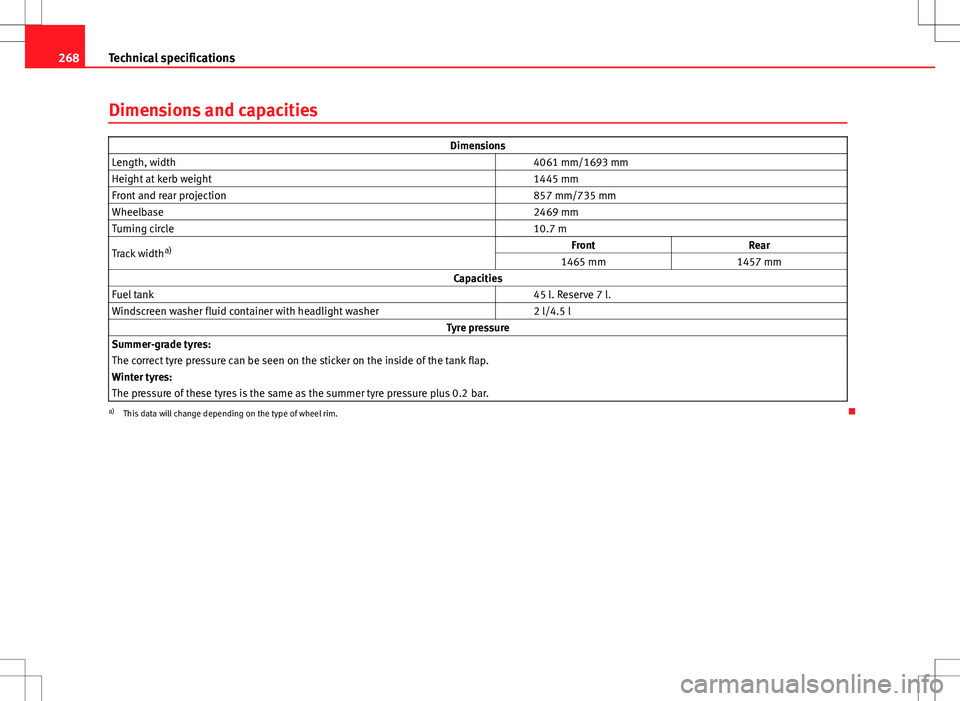
268Technical specifications
Dimensions and capacities
Dimensions
Length, width 4061 mm/1693 mm
Height at kerb weight 1445 mm
Front and rear projection 857 mm/735 mm
Wheelbase 2469 mm
Turning circle 10.7 m
Track width a) Front
Rear
1465 mm 1457 mm
Capacities
Fuel tank 45 l. Reserve 7 l.
Windscreen washer fluid container with headlight washer 2 l/4.5 l
Tyre pressure
Summer-grade tyres:
The correct tyre pressure can be seen on the sticker on the inside of the tank flap.
Winter tyres:
The pressure of these tyres is the same as the summer tyre pressure plus 0.2 bar.
a) This data will change depending on the type of wheel rim.
Page 277 of 280
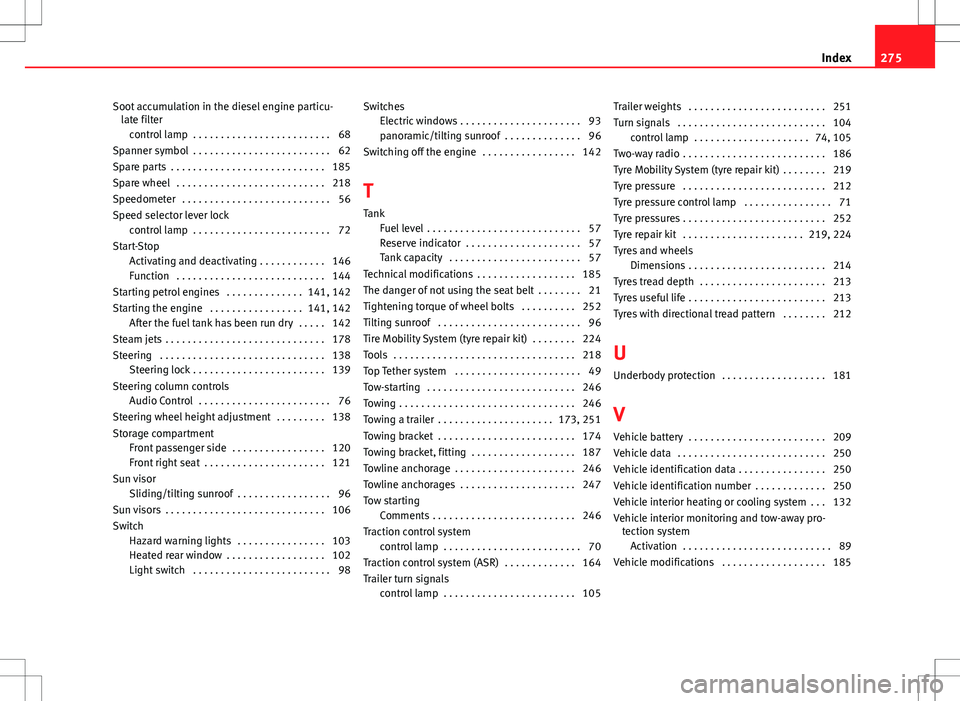
Soot accumulation in the diesel engine particu-late filter
control lamp . . . . . . . . . . . . . . . . . . . . . . . . . 68
Spanner symbol . . . . . . . . . . . . . . . . . . . . . . . . . 62
Spare parts . . . . . . . . . . . . . . . . . . . . . . . . . . . . 185
Spare wheel . . . . . . . . . . . . . . . . . . . . . . . . . . . 218
Speedometer . . . . . . . . . . . . . . . . . . . . . . . . . . . 56
Speed selector lever lock control lamp . . . . . . . . . . . . . . . . . . . . . . . . . 72
Start-Stop Activating and deactivating . . . . . . . . . . . . 146
Function . . . . . . . . . . . . . . . . . . . . . . . . . . . 144
Starting petrol engines . . . . . . . . . . . . . . 141, 142
Starting the engine . . . . . . . . . . . . . . . . . 141, 142 After the fuel tank has been run dry . . . . . 142
Steam jets . . . . . . . . . . . . . . . . . . . . . . . . . . . . . 178
Steering . . . . . . . . . . . . . . . . . . . . . . . . . . . . . . 138 Steering lock . . . . . . . . . . . . . . . . . . . . . . . . 139
Steering column controls Audio Control . . . . . . . . . . . . . . . . . . . . . . . . 76
Steering wheel height adjustment . . . . . . . . . 138
Storage compartment Front passenger side . . . . . . . . . . . . . . . . . 120
Front right seat . . . . . . . . . . . . . . . . . . . . . . 121
Sun visor Sliding/tilting sunroof . . . . . . . . . . . . . . . . . 96
Sun visors . . . . . . . . . . . . . . . . . . . . . . . . . . . . . 106
Switch Hazard warning lights . . . . . . . . . . . . . . . . 103
Heated rear window . . . . . . . . . . . . . . . . . . 102
Light switch . . . . . . . . . . . . . . . . . . . . . . . . . 98 Switches
Electric windows . . . . . . . . . . . . . . . . . . . . . . 93
panoramic/tilting sunroof . . . . . . . . . . . . . . 96
Switching off the engine . . . . . . . . . . . . . . . . . 142
T Tank Fuel level . . . . . . . . . . . . . . . . . . . . . . . . . . . . 57
Reserve indicator . . . . . . . . . . . . . . . . . . . . . 57
Tank capacity . . . . . . . . . . . . . . . . . . . . . . . . 57
Technical modifications . . . . . . . . . . . . . . . . . . 185
The danger of not using the seat belt . . . . . . . . 21
Tightening torque of wheel bolts . . . . . . . . . . 252
Tilting sunroof . . . . . . . . . . . . . . . . . . . . . . . . . . 96
Tire Mobility System (tyre repair kit) . . . . . . . . 224
Tools . . . . . . . . . . . . . . . . . . . . . . . . . . . . . . . . . 218
Top Tether system . . . . . . . . . . . . . . . . . . . . . . . 49
Tow-starting . . . . . . . . . . . . . . . . . . . . . . . . . . . 246
Towing . . . . . . . . . . . . . . . . . . . . . . . . . . . . . . . . 246
Towing a trailer . . . . . . . . . . . . . . . . . . . . . 173, 251
Towing bracket . . . . . . . . . . . . . . . . . . . . . . . . . 174
Towing bracket, fitting . . . . . . . . . . . . . . . . . . . 187
Towline anchorage . . . . . . . . . . . . . . . . . . . . . . 246
Towline anchorages . . . . . . . . . . . . . . . . . . . . . 247
Tow starting Comments . . . . . . . . . . . . . . . . . . . . . . . . . . 246
Traction control system control lamp . . . . . . . . . . . . . . . . . . . . . . . . . 70
Traction control system (ASR) . . . . . . . . . . . . . 164
Trailer turn signals control lamp . . . . . . . . . . . . . . . . . . . . . . . . 105 Trailer weights . . . . . . . . . . . . . . . . . . . . . . . . . 251
Turn signals . . . . . . . . . . . . . . . . . . . . . . . . . . . 104
control lamp . . . . . . . . . . . . . . . . . . . . . 74, 105
Two-way radio . . . . . . . . . . . . . . . . . . . . . . . . . . 186
Tyre Mobility System (tyre repair kit) . . . . . . . . 219
Tyre pressure . . . . . . . . . . . . . . . . . . . . . . . . . . 212
Tyre pressure control lamp . . . . . . . . . . . . . . . . 71
Tyre pressures . . . . . . . . . . . . . . . . . . . . . . . . . . 252
Tyre repair kit . . . . . . . . . . . . . . . . . . . . . . 219, 224
Tyres and wheels Dimensions . . . . . . . . . . . . . . . . . . . . . . . . . 214
Tyres tread depth . . . . . . . . . . . . . . . . . . . . . . . 213
Tyres useful life . . . . . . . . . . . . . . . . . . . . . . . . . 213
Tyres with directional tread pattern . . . . . . . . 212
U Underbody protection . . . . . . . . . . . . . . . . . . . 181
V
Vehicle battery . . . . . . . . . . . . . . . . . . . . . . . . . 209
Vehicle data . . . . . . . . . . . . . . . . . . . . . . . . . . . 250
Vehicle identification data . . . . . . . . . . . . . . . . 250
Vehicle identification number . . . . . . . . . . . . . 250
Vehicle interior heating or cooling system . . . 132
Vehicle interior monitoring and tow-away pro- tection system
Activation . . . . . . . . . . . . . . . . . . . . . . . . . . . 89
Vehicle modifications . . . . . . . . . . . . . . . . . . . 185
275
Index